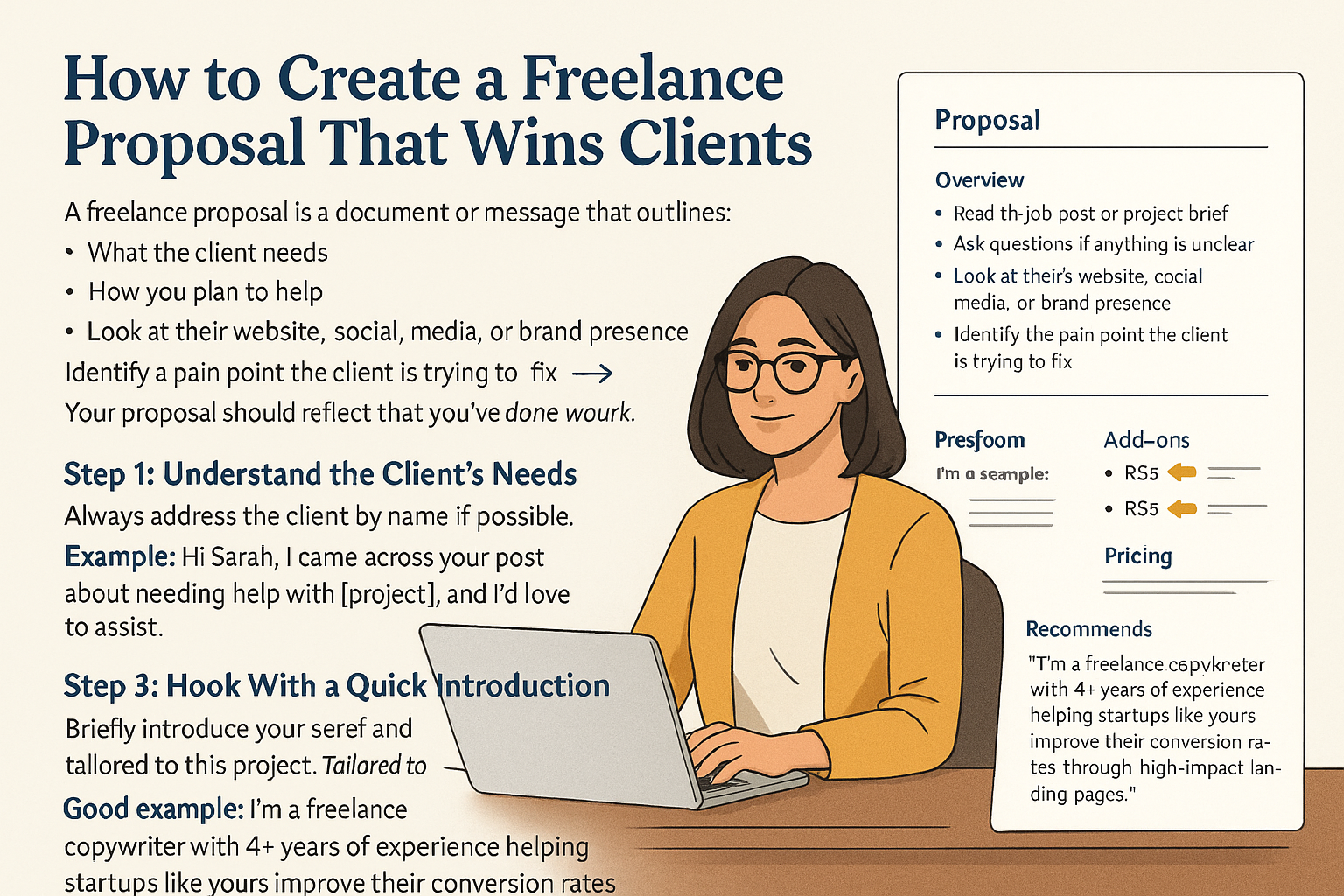A strong freelance proposal is often the difference between landing a new client—or hearing nothing back. Whether you’re a writer, designer, developer, or virtual assistant, your proposal needs to be clear, professional, and focused on solving the client’s problem. In this article, you’ll learn how to create a winning freelance proposal that stands out and gets responses.
What Is a Freelance Proposal?
A freelance proposal is a document or message that outlines:
- What the client needs
- How you plan to help
- What it will cost
- When it will be done
- Why you’re the right person for the job
It’s not just about you—it’s about how your solution benefits the client.
Step 1: Understand the Client’s Needs
Before writing anything, make sure you truly understand what the client wants.
How:
- Read the job post or project brief carefully
- Ask questions if anything is unclear
- Look at their website, social media, or brand presence
- Identify the pain point they’re trying to fix
Your proposal should reflect that you’ve done your homework.
Step 2: Start With a Personalized Greeting
Always address the client by name if possible. This small detail instantly makes your proposal more personal and thoughtful.
Example:
Hi Sarah,
I came across your post about needing help with [project], and I’d love to assist.
Step 3: Hook With a Quick Introduction
Briefly introduce who you are and what you do—tailored to this project.
Good example:
I’m a freelance copywriter with 4+ years of experience helping startups like yours improve their conversion rates through high-impact landing pages.
Keep it short. This isn’t your résumé.
Step 4: Focus on Their Problem, Not Your Skills
Avoid listing all your services. Instead, explain how you’ll solve their specific problem.
Example:
Based on what you described, I’d recommend a 3-step approach:
- Review your current content and identify optimization gaps
- Rewrite your landing page with strong, conversion-focused copy
- A/B test headlines and CTAs to improve performance
This shows strategy, not just execution.
Step 5: Share Relevant Work (Not Everything)
Only include samples that are directly related to the project type or industry.
Ways to share:
- Link to a portfolio page
- Attach 1–2 files
- Mention specific results (“My last client increased signups by 28% after we implemented this format.”)
If you’re new, create 1–2 mock samples instead.
Step 6: Outline the Deliverables and Timeline
Show the client what they’ll receive and when.
Example:
Here’s what I’ll deliver:
- 1x landing page (up to 500 words)
- 2 revision rounds
- Final delivery in Google Docs format
Timeline: 5 business days from project start
This builds clarity and avoids future confusion.
Step 7: Add Pricing and Payment Terms
Be transparent. Clients appreciate clear pricing with no surprises.
Example:
Project rate: $300 USD
50% deposit to begin, 50% due upon deliveryOptional add-ons:
- Extra revision: $50
- Urgent delivery (3 days): +$75
If you’re using a platform, the payment system may be built-in.
Step 8: Close With Confidence and a Call to Action
Wrap up your proposal with enthusiasm and invite the client to respond.
Example:
I’d love to work with you on this—feel free to message me if you have any questions or would like to get started.
Looking forward to hearing from you!
Keep it friendly but professional.
Optional: Add a Visual Proposal Template
If you want to stand out, consider creating a short visual proposal in Canva or Google Slides. This can include:
- A cover page
- Your proposed process
- Visual examples of past work
- Testimonials or logos
- Project summary and pricing
Use this especially for design, branding, or high-ticket projects.
Bonus Tips for Winning Proposals
✅ Keep it concise (1 page or less for most projects)
✅ Avoid jargon—be clear and simple
✅ Proofread carefully
✅ Use the client’s language (mirror their tone)
✅ Don’t make it about you—make it about them
Final Thoughts: Proposals Are Your Sales Tool
Your proposal is your first real chance to prove your value. It’s not just about writing well—it’s about showing the client that you understand them, that you care, and that you have a plan.
Take your time to personalize each one. A thoughtful, strategic proposal will almost always beat a copy-pasted pitch.
The goal? Make them think:
“This is exactly who I’ve been looking for.”

